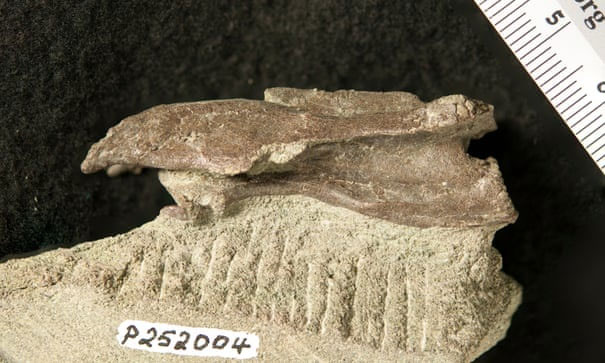Discovered super rare fossils of long-necked dinosaurs related to T-rex
In Victoria, Australia, archaeologists discovered fossils of a long-necked dinosaur, thought to evolve into a plant-eating species from their predatory ancestors.
According to the Guardian, a relative of T-rex and Velociraptor dinosaurs with unusually long necks was discovered in Australia. Scientists also believe that this dinosaur was once a predator but later evolved into a plant-eating type.
The Elaphrosaur is a member of the theropod family of dinosaurs, including predators. It stands with its hind legs, about 2 meters high and has short arms with 4 fingers on the hand.

Photo restored new dinosaur.
Stephen Poropat, who works at Swinburne University of Technology in Melbourne, led the study and said the elaphrosaur is a truly rare species, with only three species discovered in China, Tanzania and Argentina.
"This is the first time they have been found in Australia," said Propat.
Steve Brusatte, a paleontologist at the University of Edinburgh, said the elaphrosaurs were little known and studied because too few of their fossils were discovered. Scientists believe that they run fast, agile, have a long neck and turn from carnivores to herbivores.

A sample of an ancient vertebrae of an elaphrosaur was discovered in Australia. (Photo: Melbourne Museum).
According to new findings published in the scientific journal Gondawana Research, the only fossil of this species in Australia is a single vertebra - found at the excavation site near Cape Otway, 3 hours drive from Melbourne.
Instead of excavating on the sand as usual, the scientists found the fossilized vertebrae of the elaphrosaur on the gray rocks along the coast, which is often flooded.
Found by a volunteer, a 5 cm long vertebra is later included in the Melbourne Museum collection. Based on the elongated shape of the spine bone, it was originally thought to belong to a flying lizard instead of a dinosaur.
A few years later, a Swinburne graduate student, Adele Pentland, came to view the fossil sample as part of an Australian pterosaur study, only to discover it belonged to a completely different animal.
"I've heard about this vertebra in the museum collection, which is labeled as the vertebra's vertebrae. But the neck vertebrae is very special and this is not so , " she said. Pentland share.
So, the graduate student and her professor Propat returned to find out if this vertebrae belonged to the species. After identifying they belong to a species of the theropod family, and then realized the fossil resemblance of an Elaphrosaurus discovered in Africa.
- Discover long-necked dinosaurs in the ice continent
- Brazil discovered the world's oldest long-necked fossil dinosaurs
- Discovered super long neck dinosaurs
- Finding dinosaurs with super long necks
- 10 weird, hard to imagine dinosaurs
- Dinosaurs also migrate
- Why are long-necked dinosaurs gigantic?
- Discover dinosaur fossils like real Loch Ness monsters
- Long-necked dinosaurs do not face the neck up high?
- Discover new giant dinosaurs in Russia
- Finding dinosaurs like the Loch Ness monster
- Detection of extremely rare dinosaur fossils in the UK
 Discovered an ancient centipede fossil 99 million years old
Discovered an ancient centipede fossil 99 million years old Discovered bat-like dinosaurs in China
Discovered bat-like dinosaurs in China Discovered a 200-year-old bronze cannon of the coast
Discovered a 200-year-old bronze cannon of the coast Discover 305 million-year-old spider fossils
Discover 305 million-year-old spider fossils